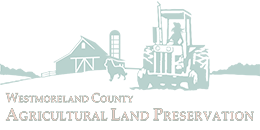Agricultural Security Areas

Agricultural Security Areas
The agricultural security area law (Act 43 of 1981) provides a tool for strengthening and protecting agriculture in Pennsylvania.
Agricultural Security Areas promote more permanent and viable farming operations over the long-term by strengthening the farming community’s sense of security in the land use and their right to farm. Township governments create Agricultural Security Areas (ASA) at the request of farmland owners. A township or municipality may establish an ASA with 250 acres of farmland owned by multiple landowners with tracts of 10 acres or more.
ASA’s provide three main benefits to landowners:
- The Township Supervisors agree to support agriculture by not passing nuisance laws that would restrict normal farming operations.
- Limitations are placed on the ability of government to condemn farmland in the ASA for highways, parks, schools, or municipal projects.
- Landowners will be eligible to voluntarily apply to sell a conservation easement to the County Agricultural Land Preservation Board.
Eligible Property
- Land owned by more than one landowner in a township, borough or municipality that totals a minimum of 250 acres. The farms that make up the 250 acres must be at least 10 acres each and need not be adjacent to one another.
- At least 50% of the soils on that land must have a soil capability class of I-IV, as determined by the USDA Soil Survey.
- The land must be viable agricultural land.
- Zoning shall permit agricultural use, but need not exclude other uses.
Procedure for Creating Agricultural Security Areas
- Landowners submit a petition to create an Agricultural Security Area to the township supervisors. The petition must include the signatures and address of the landowners, tax parcel numbers, and the number of acres of each farm tract.
- If the proposed Security Area contains land in more than one township, a petition to create a Security Area must be submitted to each township involved.
- The township supervisors acknowledge the receipt of the petition at their next meeting, publish a notice in the newspaper, and post five notices in the township stating that a petition has been received.
- For 15 days after publishing the notice, the supervisors and the township planning commission may receive proposed modifications to the Security Area from adjacent municipalities or landowners in, adjacent to, or near the proposed Security Area.
- The chairman of the township board of supervisors appoints five persons to the agricultural security area advisory committee: Three farmers, one non-farmer and one supervisor who will serve as the chairman of the committee.
- The township supervisors, at the expiration of the 15-day period for receiving proposed modifications, send the Security Area proposal and any modification received to the township planning commission and advisory committee. Each body may take up to 45 days to make a recommendation to the supervisors of whether or not the ASA should be established. (A list of criteria on which to base the recommendations is available from the Agricultural Land Preservation Board.)
- Upon receipt of the recommendations from the advisory committee and the planning commission, the township supervisors hold an advertised public hearing on the proposed ASA. Notice of the hearing is made to each landowner who is included in the proposal for creation of an Agricultural Security Area.
- The township supervisors take action to adopt the ASA proposal or any modification of it. The supervisors must make a decision within 180 days from the date the petition was submitted by the landowners. Failure of the supervisors to act within 180 days shall be deemed adoption of the Security Area proposal as originally submitted without modification.
Additions & Modifications to Agricultural Security Areas
- Additional lands may be added to an existing ASA on a voluntary basis by the landowners at any time.
- An addition of land to the existing ASA is subject to the same procedure as in the creation of an Agricultural Security Area.
- Agricultural Security Areas shall be reviewed and reestablished every seven years. The seventh year review serves as a way to check whether the agricultural security area continues to make a contribution to the preservation of the agricultural, economic, and environmental well being in the community.
Agricultural Security Areas
If you would like to complete an Agricultural Security Area application, please click the following link to download the
The Application is a PDF file and requires Adobe Reader to open.
Applications will be accepted at any time, with a cut-off date of September 1st for consideration of an agricultural conservation easement in the next round of funding. Please submit your application to:
Westmoreland County Agricultural Land Preservation Board
214 Donohoe Road, Suite B
Greensburg, PA 15601
For assistance in completing this form, or for any questions, please call 724-837-8971
